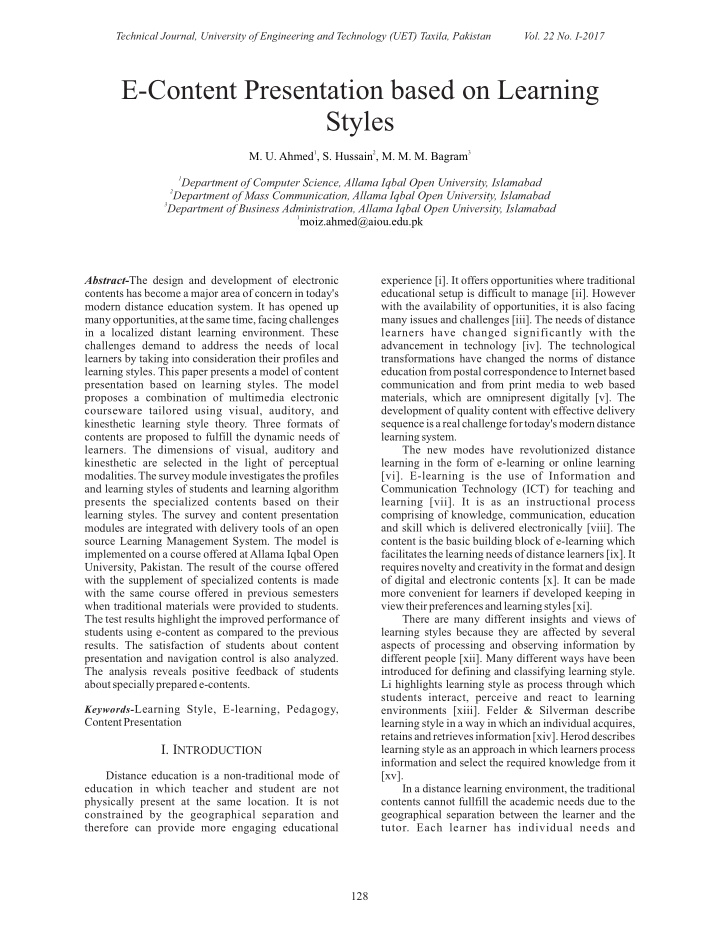



experience [i]. It offers opportunities where traditional and learning styles of students and learning algorithm when traditional materials were provided to students. with the same course offered in previous semesters with the supplement of specialized contents is made University, Pakistan. The result of the course offered implemented on a course offered at Allama Iqbal Open source Learning Management System. The model is modules are integrated with delivery tools of an open learning styles. The survey and content presentation presents the specialized contents based on their modalities. The survey module investigates the profiles students using e-content as compared to the previous kinesthetic are selected in the light of perceptual learners. The dimensions of visual, auditory and contents are proposed to fulfill the dynamic needs of kinesthetic learning style theory. Three formats of courseware tailored using visual, auditory, and proposes a combination of multimedia electronic presentation based on learning styles. The model learning styles. This paper presents a model of content learners by taking into consideration their profiles and challenges demand to address the needs of local The test results highlight the improved performance of results. The satisfaction of students about content many opportunities, at the same time, facing challenges E-Content Presentation based on Learning 1 moiz.ahmed@aiou.edu.pk 3 Department of Business Administration, Allama Iqbal Open University, Islamabad 2 Department of Mass Communication, Allama Iqbal Open University, Islamabad 1 Department of Computer Science, Allama Iqbal Open University, Islamabad 3 2 1 M. U. Ahmed , S. Hussain , M. M. M. Bagram Styles therefore can provide more engaging educational presentation and navigation control is also analyzed. constrained by the geographical separation and physically present at the same location. It is not education in which teacher and student are not Distance education is a non-traditional mode of I. I NTRODUCTION Content Presentation Keywords- Learning Style, E-learning, Pedagogy, about specially prepared e-contents. The analysis reveals positive feedback of students in a localized distant learning environment. These modern distance education system. It has opened up educational setup is difficult to manage [ii]. However facilitates the learning needs of distance learners [ix]. It content is the basic building block of e-learning which and skill which is delivered electronically [viii]. The comprising of knowledge, communication, education learning [vii]. It is as an instructional process Communication Technology (ICT) for teaching and [vi]. E-learning is the use of Information and learning in the form of e-learning or online learning The new modes have revolutionized distance learning system. of digital and electronic contents [x]. It can be made sequence is a real challenge for today's modern distance development of quality content with effective delivery materials, which are omnipresent digitally [v]. The communication and from print media to web based education from postal correspondence to Internet based transformations have changed the norms of distance advancement in technology [iv]. The technological learners have changed significantly with the many issues and challenges [iii]. The needs of distance with the availability of opportunities, it is also facing requires novelty and creativity in the format and design more convenient for learners if developed keeping in contents has become a major area of concern in today's learning style as an approach in which learners process Abstract- The design and development of electronic 128 tutor. Each learner has individual needs and geographical separation between the learner and the contents cannot fullfill the academic needs due to the In a distance learning environment, the traditional [xv]. information and select the required knowledge from it retains and retrieves information [xiv]. Herod describes view their preferences and learning styles [xi]. learning style in a way in which an individual acquires, environments [xiii]. Felder & Silverman describe students interact, perceive and react to learning Li highlights learning style as process through which introduced for defining and classifying learning style. different people [xii]. Many different ways have been aspects of processing and observing information by learning styles because they are affected by several There are many different insights and views of Technical Journal, University of Engineering and Technology (UET) Taxila, Pakistan Vol. 22 No. I-2017
Recommend
More recommend